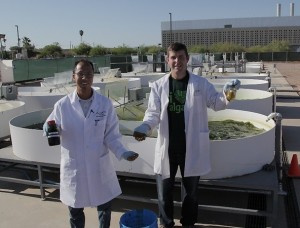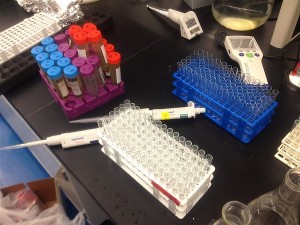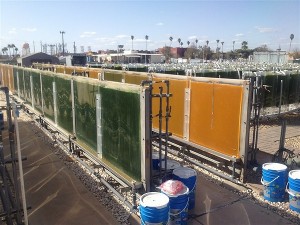June 14, 2012
 Almost one year ago, ASU graduate students and Laboratory of Algae Research and Biotechnology (LARB) student workers Joshua Wray, Martha Kent, and Emil Puruhito were granted the P3 Award from the EPA for their project "Developing Commercially Viable Culture Media from Wastewaters Optimized for the Emerging Microalgae-based Biofuel Industry." The P3 Award is a national student design competition for sustainability that focuses on people, prosperity, and the planet. These forward thinking ASU graduate students incorporated the three principle ‘P’s’ necessary to win research funding toward their project for a one year period from August 15, 2011 through August 14, 2012.
Almost one year ago, ASU graduate students and Laboratory of Algae Research and Biotechnology (LARB) student workers Joshua Wray, Martha Kent, and Emil Puruhito were granted the P3 Award from the EPA for their project "Developing Commercially Viable Culture Media from Wastewaters Optimized for the Emerging Microalgae-based Biofuel Industry." The P3 Award is a national student design competition for sustainability that focuses on people, prosperity, and the planet. These forward thinking ASU graduate students incorporated the three principle ‘P’s’ necessary to win research funding toward their project for a one year period from August 15, 2011 through August 14, 2012.
The objective of their project focused on finding a sustainable and cost-efficient way to use standard wastewater treatment practices to develop an inexpensive algae culture media. An algae culture media is a nutrient rich solution (along with carbon dioxide and light) that provides the materials necessary for algae to grow. Nutrients such as nitrogen (N), phosphate (P), and potassium (K) are all nutrients that algae love. The project concentrated on treating wastewater to develop multiple wastewater streams rich with nutrients thus creating a viable algae culture media to suffice the demand of an affordable and sustainable solution for biofuel production.
The project aimed at benefiting people as well as the planet by reducing nutrient pollution from recapturing waste nutrients, improving overall water and air quality, and creating new jobs. The project also aimed at providing additional revenue or reducing production costs of agricultural producers, as well as diminishing competition of fertilizer supplies between the biofuel industry and the food crop industry.
I talked with Joshua Wray as he reflected upon his experience with the EPA granted P3 award from the project’s very beginnings, to its present standing, and lessons learned to guide the future.
Big Beginnings
 Wray first became interested in algae because of its potential to be used as a biofuel. He soon realized that the cost to fertilize enough algae for a significant amount of biofuel would be highly expensive. Wray wanted to provide a cultivation media for the growth of algae for biofuel production that would be both low-cost and sustainable to our environment. Wray, along with his fellow student workers Kent and Puruhito, began to work with dairy waste from a neighboring dairy farm to test the feasibility of using the waste as a culture media for algae growth. The team developed a process of harvesting the waste, concentrating nutrients such as nitrogen and phosphorus that algae thrive on, and then carefully treating the media so as to not contaminate the algae culture. The results showed promise due to the success of growing a robust local strain of algae with high oil content on the waste water culture media. With a successful strategy and help from members at AzCATI, the team applied for the P3 Phase 1 Award from the EPA website in hopes of further refining a protocol and testing media derived from different waste streams.
Wray first became interested in algae because of its potential to be used as a biofuel. He soon realized that the cost to fertilize enough algae for a significant amount of biofuel would be highly expensive. Wray wanted to provide a cultivation media for the growth of algae for biofuel production that would be both low-cost and sustainable to our environment. Wray, along with his fellow student workers Kent and Puruhito, began to work with dairy waste from a neighboring dairy farm to test the feasibility of using the waste as a culture media for algae growth. The team developed a process of harvesting the waste, concentrating nutrients such as nitrogen and phosphorus that algae thrive on, and then carefully treating the media so as to not contaminate the algae culture. The results showed promise due to the success of growing a robust local strain of algae with high oil content on the waste water culture media. With a successful strategy and help from members at AzCATI, the team applied for the P3 Phase 1 Award from the EPA website in hopes of further refining a protocol and testing media derived from different waste streams.
Wray describes working with algae as a big puzzle that must be patiently pieced. Although only in its early stages, he can clearly see his project having great potential with the future of biofuel. Wray and his fellow workers, upon winning the P3 Phase 1 Award, were able to piece more of the “algae puzzle” together and continue to move the project forward.
Present Progress
 With the success of phase I of the P3 project, the team has now moved on to incorporating swine, poultry, and municipal waste into their wastewater treatment process. Although they are still testing for a way to decrease contamination in the media, the team has been able to develop an algae culture media in just seven days.
With the success of phase I of the P3 project, the team has now moved on to incorporating swine, poultry, and municipal waste into their wastewater treatment process. Although they are still testing for a way to decrease contamination in the media, the team has been able to develop an algae culture media in just seven days.
Despite the fact the team was not awarded the P3 Phase 2 Award, they were recently awarded funding by ASU’s Edson Student Entrepreneur Initiative for furthering their research on production of omega-3 fats from algae. Omega-3 fatty acids are rich with health benefits and can be found in fish due to their tendency to feed on algae. Unlike omega-3 found from fish-oil, the omega-3 found in algae is mercury free and is sustainably produced from waste nutrients using sunlight to lower cost. This could be beneficial to pursuing new research in algae based foods.
Prospective Future
What Wray intended to gain from the project was learning to create a viable algae culture media. Although they need to do more testing, in only one year Wray and his team have accomplished just that with a successful protocol adaptable to multiple waste streams.
In addition to allocating resources and developing a protocol, Wray’s highlights from the P3 project experience included trying his hand at grant writing, and being able to network, discuss, and collaborate with other grant winners at the expo in Washington D.C.
Wray firmly believes that as human population continues to grow, recycling our nutrients will be increasingly important in the future. Through his experience with the project he has learned that good grant writing and networking skills, along with perseverance to understand the science and design of good protocol, will be the main factors in continuing to move the algae industry forward. Overall, more research must be done, but the pieces of the “algae puzzle” are falling together nicely.
Written by Gabrielle Olson, ASU LightWorks
Additional Information:
http://www.epa.gov/ncer/p3/project_websites/2012/su836016.html
http://www.azbio.org/student-innovators-get-support-from-edson

